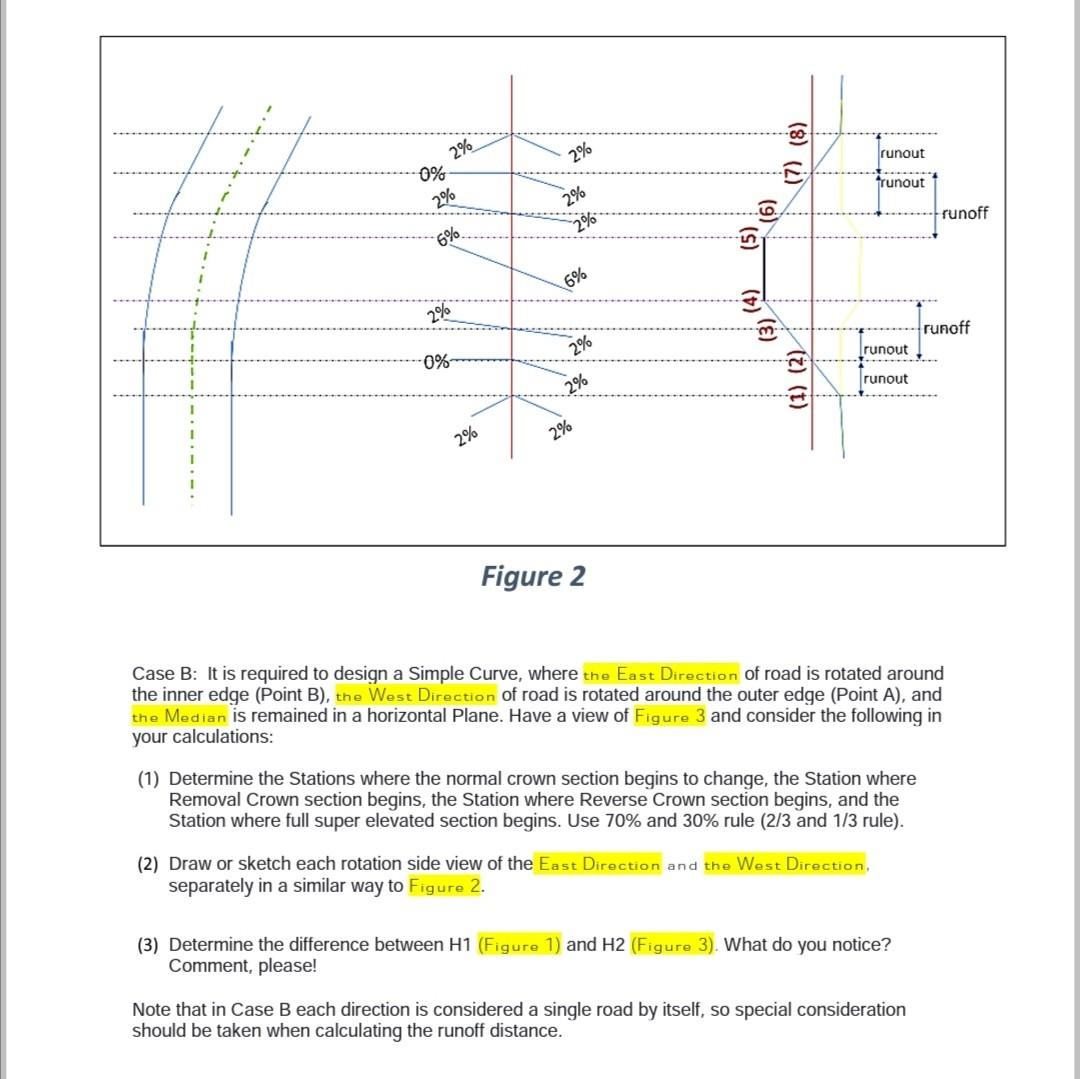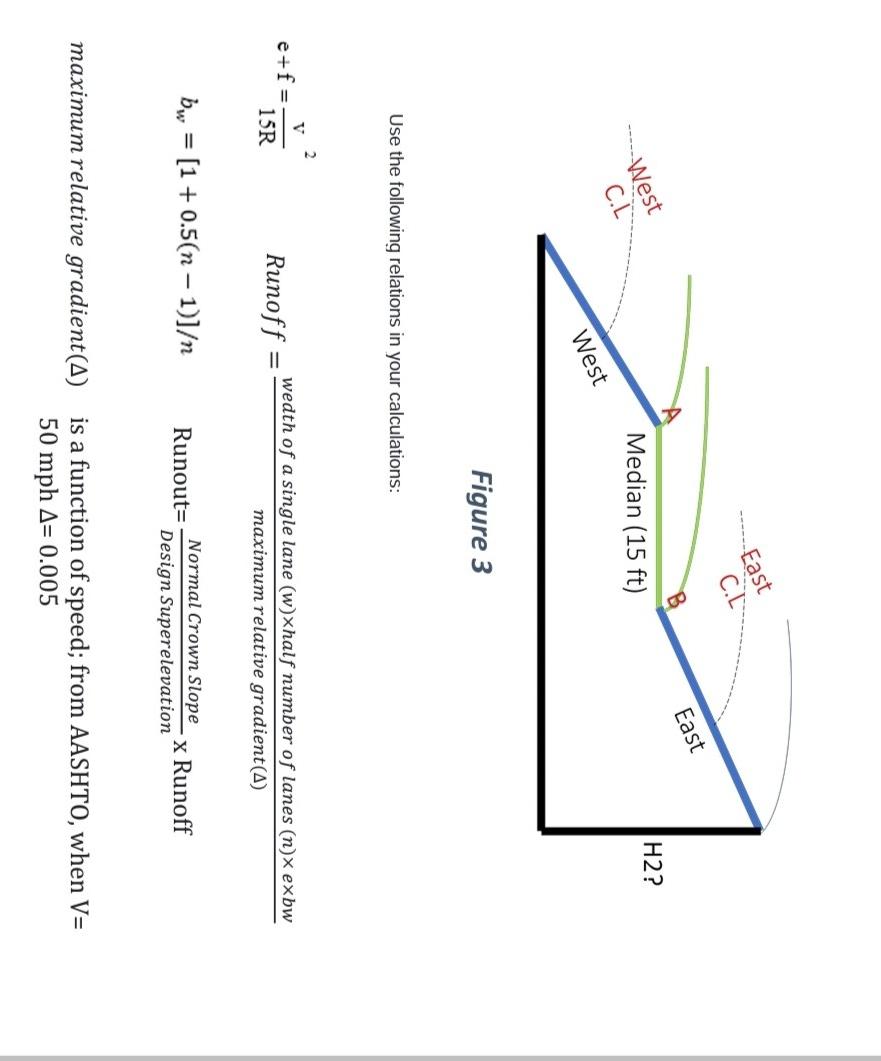Answered step by step
Verified Expert Solution
Question
1 Approved Answer
Question (1): A divided 4-lanes 2-way highway curve is to be designed in an Urban area with dry environmental conditions (e=6%) where V (design)=50 mph,



Question (1): A divided 4-lanes 2-way highway curve is to be designed in an Urban area with dry environmental conditions (e=6%) where V (design)=50 mph, PI (station)= 99+50, I = 60. Approach the two design cases below based on the previous info: Case A: It is required to design a Composite curve given that the hole cross section of road is rotated bout the Center Line (Figure 1). In the view of that, have a view of Figure 2 and answer the following: (1) What are the stations of points 1 thru 8? (2) Determine the cross-section shape of the road at each point. (3) What do points 2,4,5, and 7 denote in terms of composite curves? Use the following relations in your calculations: 2 e+f= 15R Runoff = Ls = 3.15 *v * {v? - 15e} C R C:super elevation rate ( 2 Normal Crown Slope Runout x Runoff Design Superelevation ). East H1? Road C.C: Median (15 ft) West Figure 1 2% 20% (7) (8) runout 0% Arunout 2% 2% (9) runoff 6% (5) 6% runoff 29% (4) (3) (1) (2) runout 0% 2% runout 2% 2% Figure 2 Case B: It is required to design a Simple Curve, where the East Direction of road is rotated around the inner edge (Point B), the West Direction of road is rotated around the outer edge (Point A), and the Median is remained in a horizontal Plane. Have a view of Figure 3 and consider the following in your calculations: (1) Determine the Stations where the normal crown section begins to change, the Station where Removal Crown section begins, the Station where Reverse Crown section begins, and the Station where full super elevated section begins. Use 70% and 30% rule (2/3 and 1/3 rule). (2) Draw or sketch each rotation side view of the East Direction and the West Direction, separately in a similar way to Figure 2. (3) Determine the difference between H1 (Figure 1) and H2 (Figure 3). What do you notice? Comment, please! Note that in Case B each direction is considered a single road by itself, so special consideration should be taken when calculating the runoff distance. East C.L B East H2? West C.L Median (15 ft) West Figure 3 Use the following relations in your calculations: e+f= 15R wedth of a single lane (w)xhalf number of lanes (n)x exbw Runoff = maximum relative gradient(4) bw (1 + 0.5(n - 1)] Normal Crown Slope Runout= x Runoff Design Superelevation maximum relative gradient(A) is a function of speed; from AASHTO, when V= 50 mph A= 0.005 Question (1): A divided 4-lanes 2-way highway curve is to be designed in an Urban area with dry environmental conditions (e=6%) where V (design)=50 mph, PI (station)= 99+50, I = 60. Approach the two design cases below based on the previous info: Case A: It is required to design a Composite curve given that the hole cross section of road is rotated bout the Center Line (Figure 1). In the view of that, have a view of Figure 2 and answer the following: (1) What are the stations of points 1 thru 8? (2) Determine the cross-section shape of the road at each point. (3) What do points 2,4,5, and 7 denote in terms of composite curves? Use the following relations in your calculations: 2 e+f= 15R Runoff = Ls = 3.15 *v * {v? - 15e} C R C:super elevation rate ( 2 Normal Crown Slope Runout x Runoff Design Superelevation ). East H1? Road C.C: Median (15 ft) West Figure 1 2% 20% (7) (8) runout 0% Arunout 2% 2% (9) runoff 6% (5) 6% runoff 29% (4) (3) (1) (2) runout 0% 2% runout 2% 2% Figure 2 Case B: It is required to design a Simple Curve, where the East Direction of road is rotated around the inner edge (Point B), the West Direction of road is rotated around the outer edge (Point A), and the Median is remained in a horizontal Plane. Have a view of Figure 3 and consider the following in your calculations: (1) Determine the Stations where the normal crown section begins to change, the Station where Removal Crown section begins, the Station where Reverse Crown section begins, and the Station where full super elevated section begins. Use 70% and 30% rule (2/3 and 1/3 rule). (2) Draw or sketch each rotation side view of the East Direction and the West Direction, separately in a similar way to Figure 2. (3) Determine the difference between H1 (Figure 1) and H2 (Figure 3). What do you notice? Comment, please! Note that in Case B each direction is considered a single road by itself, so special consideration should be taken when calculating the runoff distance. East C.L B East H2? West C.L Median (15 ft) West Figure 3 Use the following relations in your calculations: e+f= 15R wedth of a single lane (w)xhalf number of lanes (n)x exbw Runoff = maximum relative gradient(4) bw (1 + 0.5(n - 1)] Normal Crown Slope Runout= x Runoff Design Superelevation maximum relative gradient(A) is a function of speed; from AASHTO, when V= 50 mph A= 0.005
Step by Step Solution
There are 3 Steps involved in it
Step: 1

Get Instant Access to Expert-Tailored Solutions
See step-by-step solutions with expert insights and AI powered tools for academic success
Step: 2

Step: 3

Ace Your Homework with AI
Get the answers you need in no time with our AI-driven, step-by-step assistance
Get Started


